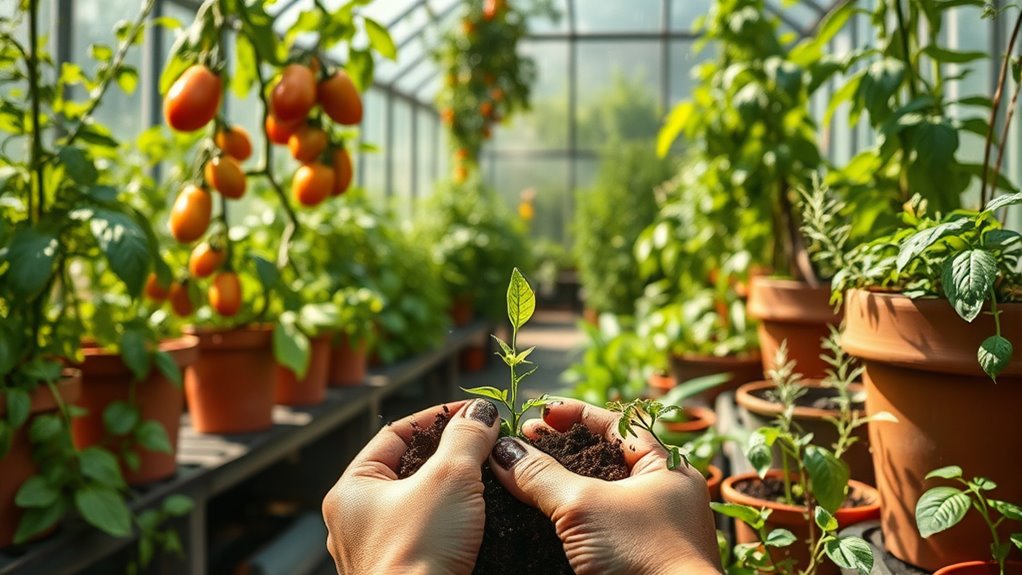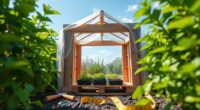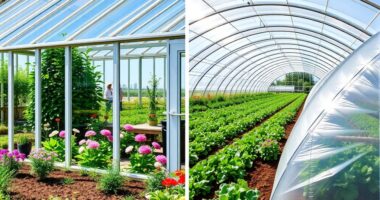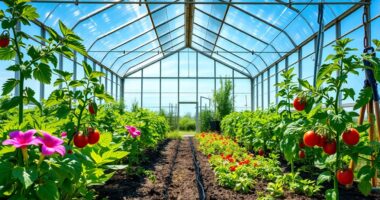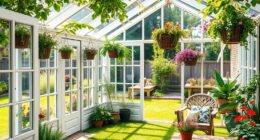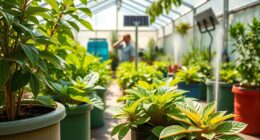If you’re starting greenhouse gardening, choose plants that thrive in your climate and conditions. Set up your greenhouse in a sunny location with good drainage, and ensure proper ventilation. Start seeds using a sterile mix, label everything, and maintain consistent temperatures and humidity. Monitor for pests and adjust your space for optimal growth. By following these key steps, you can create a thriving garden environment. There’s a lot more you can do, so keep exploring!
Key Takeaways
- Choose a greenhouse location with ample sunlight, good drainage, and a stable foundation for optimal plant growth.
- Select plants suited to your climate, such as determinate tomatoes and compact peppers, ensuring they meet light and humidity needs.
- Use a sterile seed starting mix and provide consistent moisture, light, and temperature for successful germination.
- Maintain temperatures between 80-85°F during warm months and ensure proper ventilation to prevent moisture buildup.
- Regularly inspect for pests, utilize drip irrigation, and organize plants efficiently to maximize space and health.
Choosing the Right Plants for Your Greenhouse
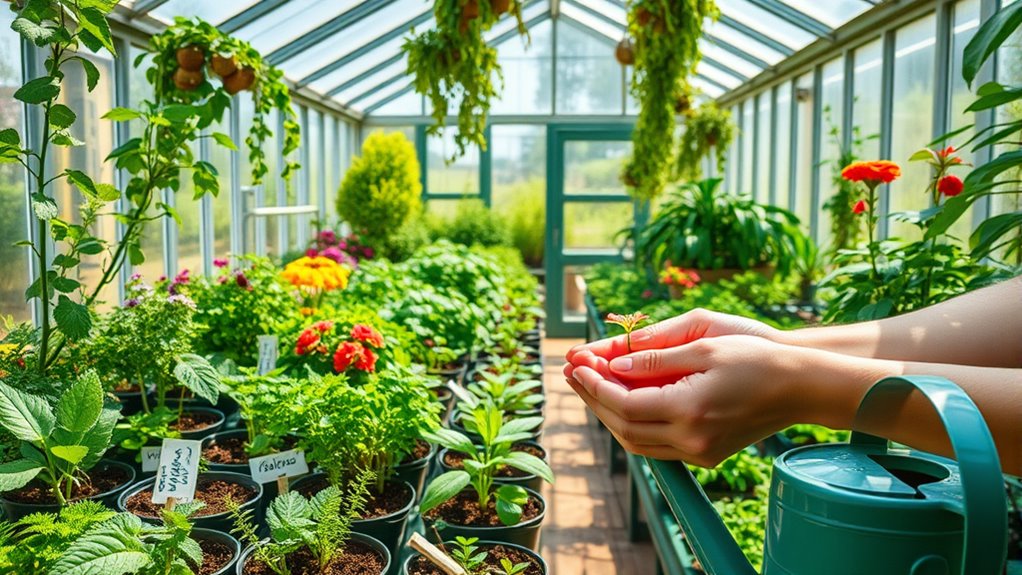
When you’re setting up your greenhouse, choosing the right plants is crucial for success. Start by considering temperature needs; most plants thrive between 65°F and 75°F.
Pay attention to humidity levels, aiming for 50% to 70% for optimal growth. Light is essential too—most plants need 12 to 16 hours daily.
For vegetables, opt for determinate tomatoes like ‘Patio Princess’ and compact peppers. Miniature cucumbers and melons thrive in controlled environments.
If you’re interested in flowers, Phalaenopsis orchids and geraniums adapt well. For herbs, basil and parsley are excellent choices that grow year-round.
Finally, if you’re a beginner, try easy-to-grow options like lettuce and green onions. Choose wisely, and you’ll enjoy a flourishing greenhouse!
Setting Up Your Greenhouse for Success
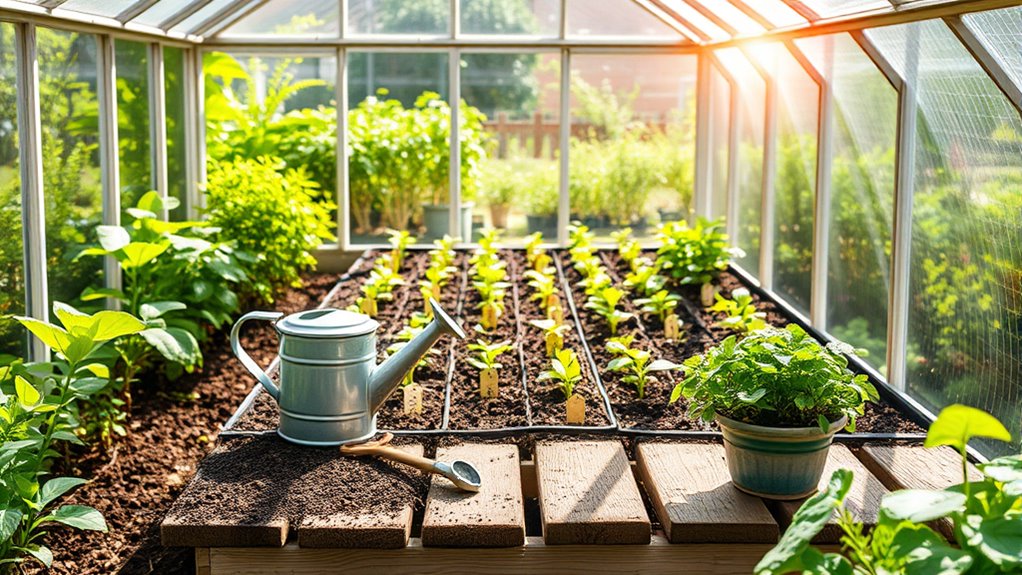
Setting up your greenhouse for success involves several key steps that lay the groundwork for thriving plants.
First, choose a location with ample sunlight, good drainage, and easy accessibility. Clear the area of debris, rocks, and weeds, ensuring the ground is level for stability. Consider a gravel base or concrete foundation for added support.
Choose a sunny, well-drained location, clear debris, and ensure a stable ground for your greenhouse foundation.
Follow manufacturer instructions for assembly and securely fasten all components. Don’t forget to install ventilation systems to regulate temperature and humidity.
Additionally, consider insulation materials and an appropriate heating system to maintain optimal conditions. Regularly monitor temperature and humidity levels to ensure a healthy environment.
With careful planning and execution, you’ll create a thriving greenhouse space for your plants.
Starting Seeds: Tips and Techniques

With your greenhouse set up for success, it’s time to focus on one of the most rewarding aspects of gardening: starting seeds.
Choose seeds that match your taste preferences and thrive in your local climate. Make sure they’re fresh and have a high germination rate.
Use a seed starting mix, keeping it moist but not soggy, and ensure it’s sterile to prevent diseases. Plant seeds at the suggested depth, spacing them properly in containers with good drainage. A good quality seed starting mix can greatly enhance your plant’s growth rate and overall health. Additionally, consider incorporating fertilization practices to further boost seedling development. State tax implications on potential future harvests can also influence your overall gardening budget. Remember that some plants, like celery juice, provide essential nutrients that can be beneficial for your overall health.
Provide sufficient light, maintaining consistent temperatures to aid germination. Label each container with the plant type and sowing date for easy tracking.
As seedlings grow, select the strongest ones and transplant them into larger containers when they develop their first true leaves. Understanding emergency preparedness essentials can also help you plan for food security in your greenhouse gardening efforts.
Managing Temperature and Humidity Levels
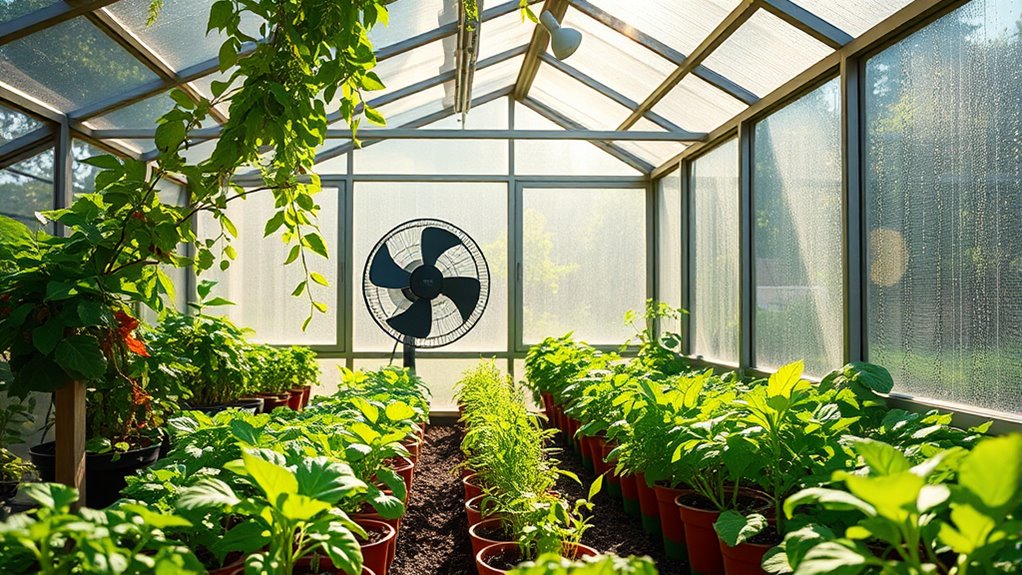
Successfully managing temperature and humidity levels in your greenhouse is crucial for promoting healthy plant growth. Aim to keep temperatures between 80-85°F (26-29°C) during spring and summer. Use thermometers to monitor these levels closely.
In colder months, electric or gas heaters can maintain warmth, while evaporative cooling systems work wonders in hot climates. Consider installing automatic vent openers to help regulate temperature efficiently.
For humidity, remember that plants release moisture through transpiration, which cools the air. You can increase humidity by dampening surfaces or using a humidifier for tropical plants.
Proper ventilation is key—utilize roof and side vents, fans, and automatic windows to ensure good air circulation, preventing excess moisture buildup and promoting healthy growth.
Addressing Common Greenhouse Challenges
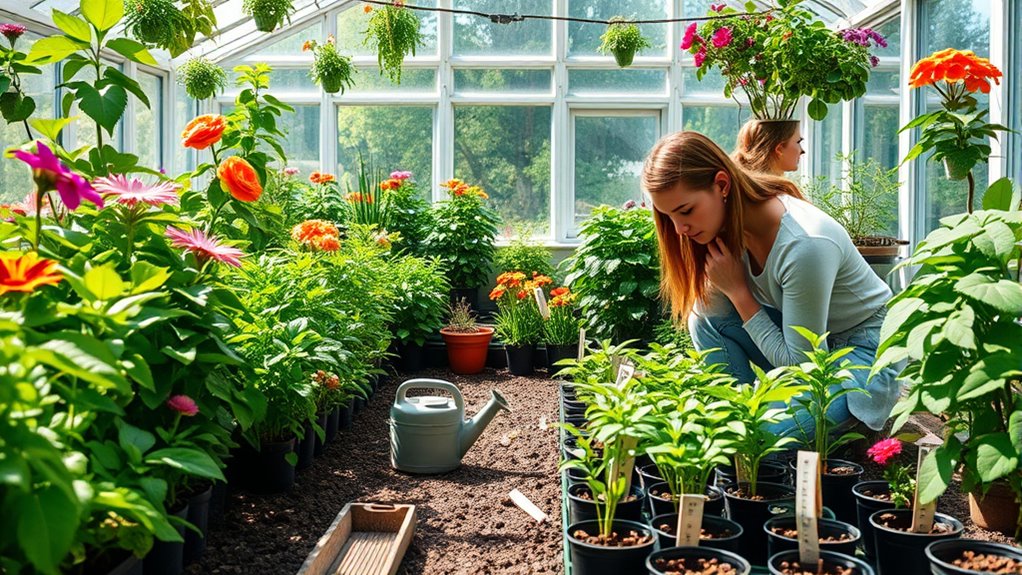
When growing plants in a greenhouse, you’ll inevitably face some common challenges that can impact their health and productivity.
Inadequate ventilation can lead to moisture buildup, fostering diseases and pests. Ensure proper airflow with roof vents and fans, and regularly inspect these systems.
Watering is another critical area; both overwatering and underwatering stress plants. Implement drip irrigation to maintain consistent moisture levels and check soil regularly.
Pests like aphids and whiteflies can invade, so perform frequent inspections and use integrated pest management strategies.
Optimize your space with vertical gardening and organized plant arrangements to maximize growth potential.
Essential Tools and Equipment for Greenhouse Gardening
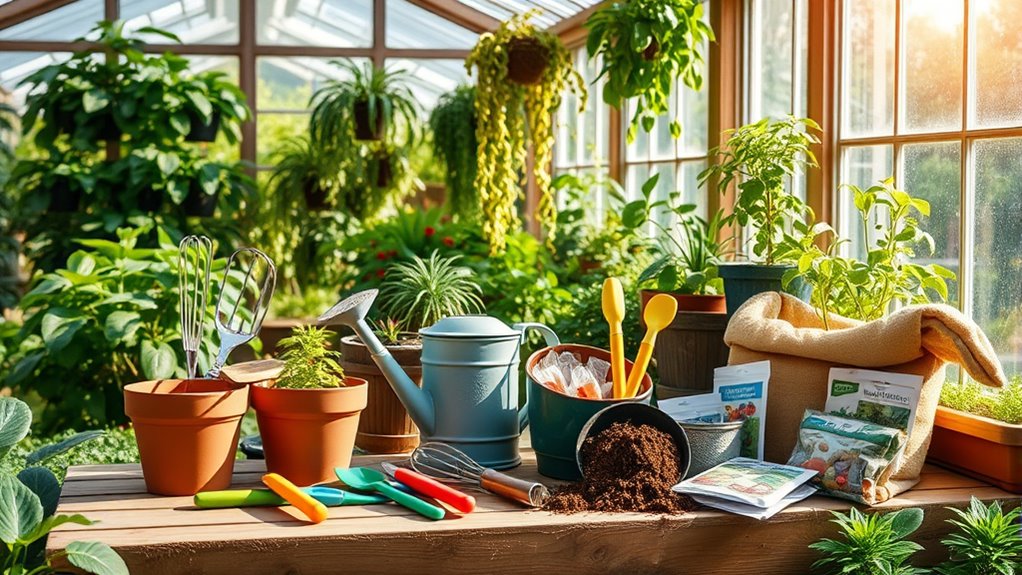
Maintaining a thriving greenhouse requires not just vigilance against challenges but also the right tools and equipment to support your gardening efforts.
Start with essential hand tools like trowels for planting, pruning shears for trimming, and gloves to protect your hands. Small hand rakes and scoops make soil management easier.
For climate control, invest in heaters and evaporative cooling systems, along with thermometers and humidity gauges to monitor conditions.
Don’t forget plant care essentials like seed trays, potting soil, and fertilizers.
To keep your greenhouse clean, use brooms, dustpans, and cleaning brushes.
Finally, consider shelving for organization and watering cans for efficient irrigation. Additionally, understanding greenhouse climate control is crucial for optimizing plant growth and ensuring a successful gardening experience.
These tools will set you up for success in your greenhouse gardening journey.
Optimizing Space and Growth in Your Greenhouse

To make the most of your greenhouse space and ensure robust plant growth, careful planning and strategic design are essential.
Start by deciding on a layout that accommodates tools and equipment while maximizing planting areas. Choose plants based on their growth habits and space needs, and consider seasonal planting to make the most of changing conditions.
Decide on an efficient layout that balances tools, equipment, and planting areas while considering plant growth habits and seasonal changes.
Utilize vertical space with hanging baskets, hydroponic towers, and planter walls to increase your planting area. Implement efficient planting strategies like succession planting and companion planting to enhance growth.
Use movable and stacked containers for versatility, and maintain optimal conditions by managing temperature, ventilation, and lighting.
With these strategies, you’ll create an efficient and productive greenhouse environment.
Frequently Asked Questions
How Much Does a Greenhouse Cost to Build or Buy?
When you’re considering how much a greenhouse costs to build or buy, expect to spend between $3,071 and $16,209 for a custom build.
If you opt for a kit, prices range from $500 to $5,000.
Remember, costs can vary based on size, materials, and location.
Be sure to factor in additional expenses like permits, ongoing maintenance, and climate control for a complete picture of your investment.
What Are the Best Materials for Greenhouse Construction?
What materials should you choose for your greenhouse?
For framing, consider wood for its aesthetics and durability, or go with PVC for lightweight convenience.
Covering options like polycarbonate offer great insulation, while polyethylene film is budget-friendly.
For foundations, concrete ensures stability.
Don’t forget insulation materials like weather stripping to keep your greenhouse cozy.
Can I Use My Greenhouse Year-Round?
Yes, you can use your greenhouse year-round!
By implementing proper climate control systems, you can create an optimal environment for various plants regardless of outside conditions.
You’ll need to manage temperature, humidity, and light carefully, especially in winter when daylight is shorter.
Consider using heating systems and insulating materials to maintain warmth.
With the right planning and equipment, you can enjoy gardening throughout the year, cultivating everything from tropical plants to frost-tolerant varieties.
How Often Should I Clean My Greenhouse?
Did you know that a well-maintained greenhouse can boost your crop yield by up to 20%?
To keep your greenhouse thriving, you should clean it at least once a year. If you use it seasonally, a fall cleanup is enough, but year-round use demands more frequent attention.
Always clean before planting new crops and sanitize after harvest to minimize pests and diseases.
Regular maintenance ensures your plants start strong and stay healthy.
What Is the Best Time to Start Planting in a Greenhouse?
The best time to start planting in your greenhouse depends on the crops you choose.
For cool-season crops like lettuce and peas, aim for early spring, around March.
Warm-season crops, such as tomatoes and peppers, should be started in late winter to early spring for optimal growth.
Conclusion
In conclusion, greenhouse gardening opens up a world of possibilities for you as a beginner. Did you know that greenhouses can increase your plant yield by up to 50% compared to outdoor gardening? By choosing the right plants, optimizing your setup, and managing conditions, you can create a thriving environment. Dive in, experiment, and enjoy the rewards of your efforts. With a little practice, you’ll be amazed at what you can grow!
